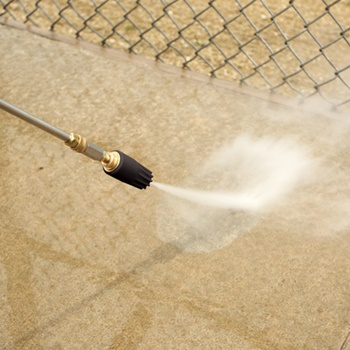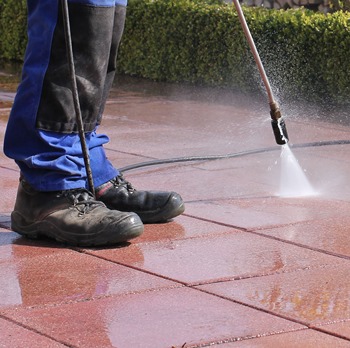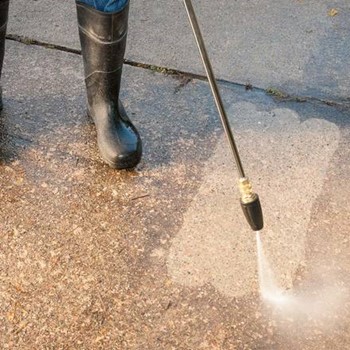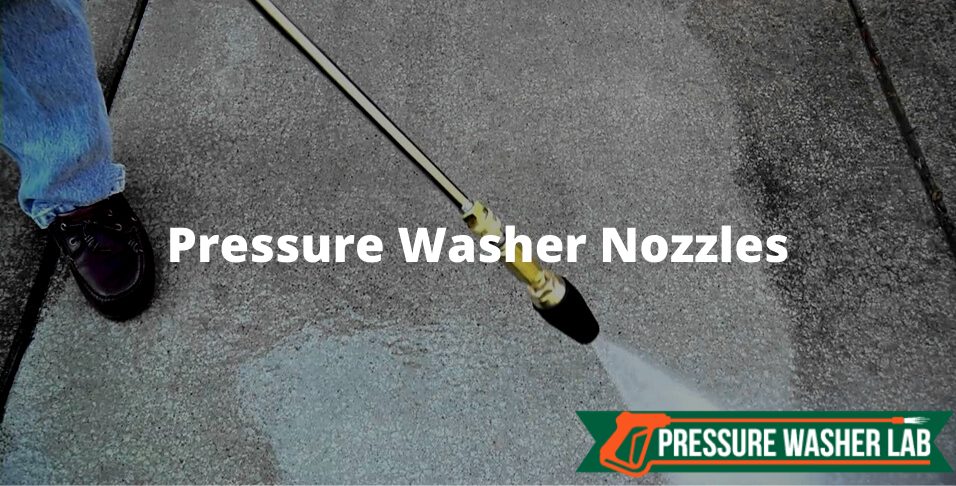The choice of a pressure washer nozzle depends on the surface that needs to be cleaned with it and the amount of dirt that needs to be removed. Pressure washer nozzles come in 5 different colors, which indicate the spray angle at which the water is released out of a pressure washer. Pressure washer nozzles are responsible for the pressure of the water propelled out of a machine. A pressure washer nozzle increases the strength of the sprayed water by decreasing the flow which is constantly under pressure, resulting in more speed.
Analyzing factors such as color or spray angle, PSI, and surface before choosing the right pressure washer nozzle is recommended. These factors are discussed in detail below.
Why Is It So Important to Choose the Right Nozzle when You’re Pressure Washing?

It is so important to choose the right nozzle in order to prevent destroying the surface that is being cleaned. Pressure nozzles have two key parts – velocity and flow that determine how the nozzle operates. When there is less flow, there will be more velocity. With increased velocity, the pressure washer nozzle can deliver more pressure and provide more cleaning power.
Less flow means higher velocity, and with more velocity, the cleaning power and the pressure washer force is increased as well. Choosing the right nozzle ensures having enough flow and velocity needed to complete the cleaning task from the desired distance.
What Happens If You Choose the Wrong Nozzle?
If the wrong nozzle is chosen, the wood or deck surfaces might be damaged, the paint might peel off the car, or the brick driveway mortar can be broken.
The Color Combinations of Pressure Washer Nozzles
Pressure washer nozzles come in 5 color combinations – red, yellow, green, white, and black, all of which are listed below.
Red Nozzle
The red nozzle or 0-degree nozzle is the smallest one since it covers the area the size of a quarter coin. The red nozzle sprays the water at maximum pressure and directly onto the surface that is being cleaned.
Yellow Nozzle
The 15-degree yellow nozzle has a wider spray compared to the red nozzle. Since the yellow nozzle delivers more water over a larger area, the pressure of water delivered is lower.
Green Nozzle
The green 25-degree nozzle delivers a wide spray of water that has very low pressure and is less likely to damage the surface that is being cleaned.
White Nozzle
The 40-degree white nozzle delivers the lowest water pressure and it sprays water over a wide surface. The 40-degree nozzle is most suitable for cleaning windows and other gentle surfaces.
What Are the Different Types of Pressure Washer Nozzles?
 The 7 types of pressure washer nozzles are listed below:
The 7 types of pressure washer nozzles are listed below:
1. 0-Degree Red Tip Nozzle
The 0-degree red tip nozzle is the one with the smallest area coverage, but with the highest pressure. The 0-degree red tip nozzle sprays water at full force, which reduces the flow and increases velocity. The 0-degree red tip nozzle takes more time to clean the surface while it should be used carefully since it can damage the surface that is being cleaned. The 0-degree red tip nozzle is most suitable for cleaning tough dirt and rust. To prevent damaging the surface, the 0-degree red tip nozzle should be used at a distance or with the pressure washer extension wand that can balance the pressure out.
2. 15-Degree Yellow Tip Nozzle
The 15-degree nozzle is less powerful than the 0-degree nozzle but it can also be used for cleaning dirt and mud stains. The 15-degree nozzle should be held at a distance or it should be used with an extension wand to prevent damages.
3. 25-Degree Green Tip Nozzle
The 25-degree nozzle is most suitable for cleaning driveways, patio furniture, cars, and boats. The pressure the 25-degree nozzle delivers is lower than the pressure the 0-degree and 15-degree nozzles deliver, while the area it covers is wider.
4. 40-Degree White Tip Nozzle
The 40-degree white tip nozzle delivers low pressure, which makes it more suitable for washing windows and blinds.
5. Adjustable/Variable Nozzle
A variable nozzle combines 5 nozzles in one and can be adjusted for cleaning any type of surface.
6. Turbo/Rotary Nozzle
The turbo or rotary nozzle is popular because it combines the 0-degree nozzle and the 25-degree nozzle. The turbo nozzle delivers water pressure between 1,800 and 3,000 PSI, combines a pulsing action, rotates the water, and cleans the surfaces in a round cone shape.
7. Soaping Black Top Nozzle
The soaping black top nozzle with a large opening delivers water spray at a wide degree. A wider degree decreases velocity and the pressure delivered. The siphon tube is an integral part of the soaping nozzle that pulls the detergent or soap into the stream of water.
Selecting a Nozzle When You’re Unsure
When unsure which nozzle to select, follow the tips listed below:
- Keep the Distance – Hold the nozzle around 24 inches away from the surface that needs to be cleaned and gradually come closer but not closer than 6 inches.
- Perform a Test – The nozzle should be tested on a small area, a corner or a deck, to ensure it doesn’t damage the surface.
- Use Common Sense – Strong-pressure nozzles such as 0-degree or 15-degree nozzles shouldn’t be used on delicate surfaces, such as wood or glass but only on hard surfaces covered with layers of dirt.
- Start Wide – Start the cleaning process with the widest angle nozzle, such as the 40-degree nozzle, then follow with a narrower nozzle.
Things to Consider when Choosing the Nozzle
 Things to consider when choosing the right nozzle are the color of the nozzle, the surface that needs to be cleaned, and the spray angle, all of which are explained below in detail.
Things to consider when choosing the right nozzle are the color of the nozzle, the surface that needs to be cleaned, and the spray angle, all of which are explained below in detail.
Know the Nozzles by Colors
Different nozzle colors are used for cleaning different surfaces and amounts of dirt. Red nozzles are used for cleaning hard surfaces such as concrete and tough dirt. Yellow nozzles are used for cleaning heavy-duty equipment and layers of dirt. Green nozzles are used for cleaning surfaces with fine finishes. White nozzles are used for window, deck, driveway, and siding washing. Black nozzles are used for applying soaps and detergents.
Consider the Surface You’re Cleaning
Blinds, windows, and painted surfaces should be pressure washed with 40-degree nozzles while hard surfaces can be pressure washed with any kind of nozzle, including the 0-degree nozzle that delivers maximum blast.
Don’t Forget the Spray Angle
A 0-degree spray angle can cover small areas while a 45-degree angle nozzle sprays water across wide surfaces.
How to Clean Your Nozzles?
Nozzles should be cleaned with a pin because debris, dirty water, corrosion, or using the wrong detergent can cause clogs and hinder the performance of the nozzle.

